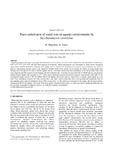| dc.description.abstract | [Please note that chemical formulae do not display correctly in this abstract]. Sorption properties of baker's yeast cells, characterised as Saccharomyces cerevisiae were evaluated for trace enrichment of metal ions: Cd2+, Cr3+, Cr6+, Cu2+, Pb2+ and Zn2+ from aqueous environments. Metal concentration was determined by flame atomic absorption spectrometry (FAAS). Parameters affecting metal uptake such as solution pH, incubation time, amount of yeast biomass and effect of glucose concentration (energy source) were optimised. Further studies were carried out to evaluate the effects on metal uptake after treating yeast with glucose as well as with an organic solvent. The results showed that trace enrichment of the metals under study with yeast, depends upon the amount of yeast biomass, pH and incubation time. Treatment of yeast cells with 10-20mM glucose concentration enhanced metal uptake with exception to Cr6+, whose metal enrichment capacity decreased at glucose concentration of 60 mM. Of the investigated organic solvents THF and DMSO showed the highest and lowest capacity, respectively, to enhance metal uptake by yeast cells. Trace enrichment of metal ions from stream water, dam water, treated wastewater from a sewage plant and wastewater from an electroplating plant achieved enrichment factors (EF) varying from 1 to 98, without pre-treatment of the sample. pH adjustment further enhanced the EF for all samples. The results from these studies demonstrate that yeast is a viable trace metal enrichment media that can be used freely suspended in solution to achieve very high EF in aquatic environments. | en |

